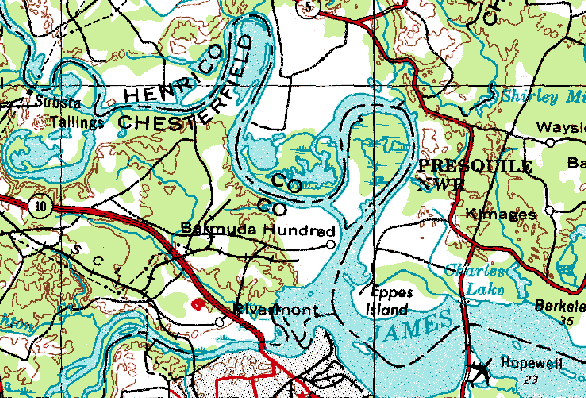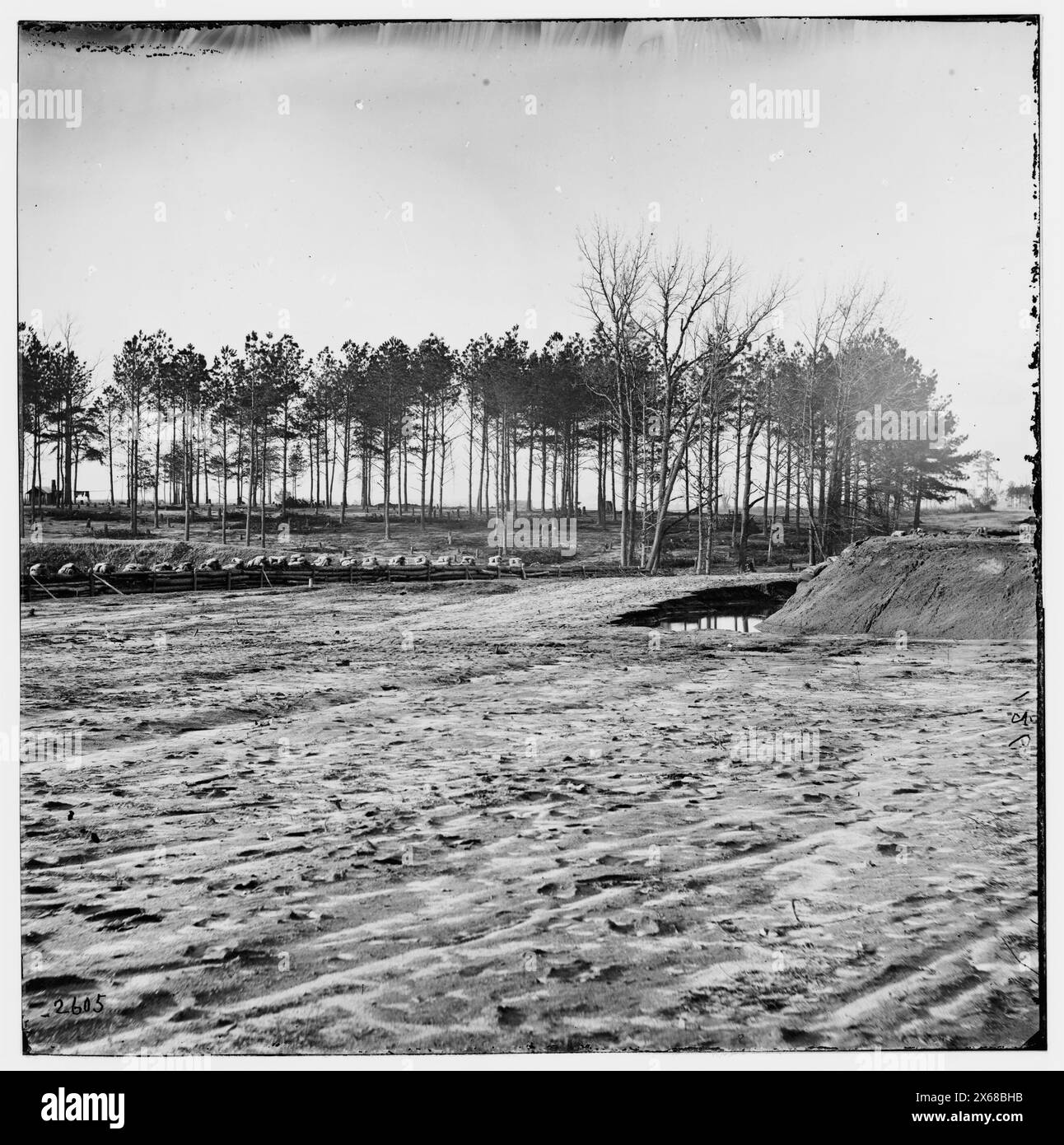
Bermuda Hundred: Where America’s Story is Written in the Earth
Beneath the placid surface of Bermuda Hundred, Virginia, lies a past so rich and tumultuous that it seems to whisper tales of four centuries with every rustle of leaves and ripple on the James River. Often overshadowed by its more famous neighbors like Jamestown and Richmond, this small peninsula, formed by the confluence of the James and Appomattox Rivers, holds a disproportionately significant place in the narrative of America. It is a place where the foundational struggles of a fledgling colony, the fierce battles for independence, and the tragic divisions of civil war all left indelible marks, making Bermuda Hundred a living, breathing testament to the enduring spirit of a nation.
To truly understand Bermuda Hundred, one must first appreciate its strategic geography. A finger of land reaching out into the vital waterways of Virginia, it was, from the very beginning, a location of immense military and economic importance. This inherent value has ensured its continuous occupation and repeated involvement in nearly every major conflict on American soil, earning it a unique, if sometimes unsung, place in history.
The Genesis of a Colony: Sir Thomas Dale’s Vision (1613)

The story of Bermuda Hundred begins not with gold, but with survival. By 1613, the Jamestown settlement, established six years prior, was still teetering on the brink of collapse. The infamous "Starving Time" had decimated its population, and disease, conflict with the Powhatan Confederacy, and mismanagement plagued the struggling venture. It was into this desperate scene that Sir Thomas Dale, a stern but visionary Marshal of Virginia, arrived. Tasked with bringing order and stability, Dale understood that Jamestown’s swampy, unhealthy location was a fundamental flaw. He sought higher, healthier ground, easily defensible and fertile enough to sustain the colonists.
His search led him upstream from Jamestown, to a commanding bluff overlooking a bend in the James River. The land, rich and well-drained, reminded him, it is said, of the distant Bermudas – islands whose name would eventually be bestowed upon this new settlement. Dale christened the larger area "Dale’s Gift" and the specific fortified town he established nearby "Henricus," named after Prince Henry of Wales. Bermuda Hundred, as the larger administrative and agricultural division, was born out of this strategic imperative.
The term "hundred" itself is an ancient English administrative division, denoting a parcel of land large enough to support a hundred families. Bermuda Hundred was one of the four original "incorporations" of the Virginia Company, and its primary purpose was agriculture. Here, the colonists, under Dale’s strict, martial laws, began to cultivate crops that would finally ensure their survival. It was also around this time that John Rolfe, another key figure in early Virginia history, began his successful experiments with a new, sweeter strain of tobacco, transforming the colony’s economic fortunes and setting the stage for the plantation system that would define the region for centuries.
The early years were fraught with danger. The Powhatan Confederacy viewed the encroaching English settlements with increasing hostility. The 1622 Powhatan Uprising, a coordinated attack that devastated many English outposts, did not spare the area. While Henricus was destroyed, the resilience of the colonists ensured that Bermuda Hundred, with its strategic advantages, would not be abandoned. It continued to grow, fueled by the insatiable European demand for tobacco, slowly transforming from a frontier outpost into a bustling agricultural hub.
Revolutionary Echoes: A Target for Tyranny (1781)
As the centuries turned, Bermuda Hundred remained a vital part of Virginia’s economic landscape. Its riverine access facilitated the transport of tobacco and other goods, connecting the inland plantations to the global trade routes. By the time of the American Revolution, this very connectivity would again place it in the crosshairs of conflict.
In 1781, as the war for independence raged, the traitor Benedict Arnold, now commanding British forces, led a devastating raid up the James River. His objective was to cripple Virginia’s economy and military capabilities, and Bermuda Hundred, with its warehouses, mills, and valuable plantations, was a prime target. Arnold’s forces swept through the area, burning, looting, and destroying property, leaving a path of destruction in their wake. It was a stark reminder that even in an age of muskets and cannon, Bermuda Hundred’s strategic position made it perpetually vulnerable.
Despite the ravages of war, the resilient spirit of the inhabitants ensured that Bermuda Hundred would rebuild. The area settled into a pattern of agrarian life, characterized by large plantations worked by enslaved African Americans, whose forced labor became the backbone of the region’s prosperity. This complex and painful chapter of American history, though often understated in general narratives, was deeply woven into the fabric of Bermuda Hundred, like countless other places in the antebellum South.

The Crucible of Civil War: Butler’s Bottleneck (1864)
It was the American Civil War, however, that would once again transform Bermuda Hundred into a critical theater of operations, etching its name into the annals of national conflict with particular intensity. By 1864, the Union’s strategy was clear: put immense pressure on the Confederate capital of Richmond and its vital supply hub, Petersburg. Bermuda Hundred, situated squarely between these two strategic objectives and controlling the main river approaches, became a battleground of immense importance.
The Union objective was to sever the Richmond-Petersburg Railroad, a lifeline for the Confederate forces. To achieve this, Major General Benjamin Butler, commanding the Army of the James, launched the Bermuda Hundred Campaign in May 1864. Butler’s plan was ambitious: land his forces at City Point and Bermuda Hundred, then push westward to cut the railroad.
The campaign quickly devolved into a series of fierce engagements. Confederate forces, under the command of General P.G.T. Beauregard, recognizing the critical threat, rapidly concentrated their defenses. Battles raged at Port Walthall Junction, Swift Creek, and most notably, Drewry’s Bluff. The Confederate fortifications at Drewry’s Bluff, formidable and strategically placed, proved to be a formidable obstacle.
Butler’s campaign ultimately failed to achieve its primary objective. Beauregard, with numerically inferior forces, skillfully maneuvered and fought, eventually "bottling up" Butler’s army on the Bermuda Hundred peninsula. Beauregard famously quipped that Butler was "corked in a bottle, and the cork is in so tight that he cannot get out." This strategic defeat meant that Butler’s army, though a significant force, was effectively neutralized for much of the crucial Overland Campaign, preventing it from linking up with General Ulysses S. Grant’s main army as intended.
The Bermuda Hundred Campaign was marked by intense fighting, heavy casualties, and the extensive construction of trenches and earthworks, many of which are still visible today. The landscape was scarred by artillery fire, troop movements, and the grim realities of total war. The plantations that had once been symbols of prosperity were now fields of battle, and the very ground beneath the soldiers’ feet was soaked in the blood of Americans fighting against Americans. It was a period of immense suffering and destruction, profoundly altering the social and economic fabric of the region.
From Ashes to Preservation: Bermuda Hundred Today
From the ashes of war, Bermuda Hundred slowly began to rebuild. The end of slavery brought about a dramatic restructuring of the agrarian economy, leading to a period of adjustment and hardship for many. Over time, the large plantations gave way to smaller farms, and eventually, the inexorable march of suburbanization began to creep in from the growing urban centers of Richmond and Petersburg.
Today, Bermuda Hundred is primarily a residential area, part of Chesterfield County, Virginia. Yet, the echoes of its past are everywhere for those who care to look and listen. Historical markers dot the landscape, commemorating battles, settlements, and significant figures. Portions of the Civil War earthworks are preserved, silent sentinels guarding the memories of the fierce struggles that once took place there.
Historians and archaeologists continue to uncover layers of Bermuda Hundred’s past, from indigenous artifacts predating English arrival to the remnants of colonial structures and Civil War encampments. The area serves as a vital outdoor museum, offering tangible connections to the earliest days of English settlement, the complexities of the antebellum South, and the defining conflict of the American nation.
"Bermuda Hundred isn’t just a location on a map," notes Dr. Sarah Jones, a local historian. "It’s a historical palimpsest, where each era has written its story over the last, but you can still read glimpses of every chapter if you know where to look. From Dale’s desperate vision to Butler’s frustrated campaign, it tells the story of America’s continuous struggle for identity and purpose."
Visiting Bermuda Hundred today is to walk through a landscape imbued with history. One can stand on the bluffs overlooking the James River and imagine Sir Thomas Dale surveying the fertile land, or picture Benedict Arnold’s ships sailing upriver in defiance. One can trace the lines of Civil War trenches and feel the weight of the past, sensing the ghost of soldiers who fought and died there.
Bermuda Hundred is not merely a place of historical events; it is a place where history happened and continues to resonate. It reminds us that the grand narratives of nations are often forged in seemingly unassuming places, and that beneath the calm veneer of the present, the past is always waiting to be rediscovered, offering invaluable lessons about resilience, conflict, and the enduring human spirit that shaped America. It is, in every sense, where America’s story is written in the earth.


